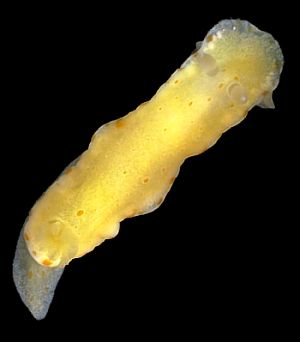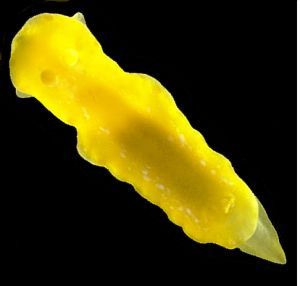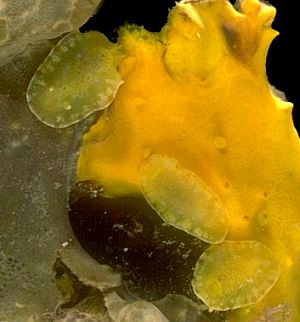
Noumea closei
Rudman, 1986
Order: NUDIBRANCHIA
Suborder: DORIDINA
Superfamily: EUDORIDOIDEA
Family: Chromodorididae
PHOTO
UPPER: Boat Harbour, Devonport, Tasmania; 1 specimen (16 mm long alive), 12m, 26 May 1985, AM C146610 - Holotype. LOWER LEFT: Horseshoe Reef, off Devonport, Tasmaania; 1 specimen (11mm long alive), 12 m, 19 February 1984, AM C141269. LOWER RIGHT: Warna Point, Louth Bay, Eyre Peninsula, South Australia; 8 specimens (5-7 mm long alive), 2 m, 11 February 1985, AM C145100. Food sponge is Darwinella sp. PHOTOS: Bill Rudman
RELATED TOPIC
The whole of the body is a uniform bright yellow, often slightly translucent in smaller specimens. There are a row of orange spots around the mantle, just in from the edge and a few scattered over the rest of the mantle. In some larger specimens the orange spots are bright and opaque while in many specimens they are more translucent. In most specimens there is a thin line of microscopic white specks right at the mantle edge and scattered white specks all over the mantle. In some specimens there are also aggregations of white specks forming a row of diffuse white patches down each side of the mantle from behind the rhinophores. In other specimens the white specks form a ring around the orange spots on the inner part of the mantle. The gills and rhinophores are a bright translucent yellow, the rhinophore club being tipped with white. Usually the underside is translucent yellow with no orange spots but sometimes there are a few orange spots forming a submarginal line along the side of the foot and around the posterior end.
The mantle is ovate with a distinct overlap and the body has a relatively low profile. The mantle glands are ovate globules forming a submarginal band around the mantle edge and are quite visible, especially in juvenile specimens. In one specimen a granular white secretion was extruded from the mantle glands through pores on the dorsal surface. The simple gills form a circlet around the anus in the postero-dorsal midline. The anterior edge of the foot is developed into a rounded foot corner on each side which extends beyond the mantle overlap when the animal is crawling.
This species is known from Victoria, Tasmania and South Australia and has been found on a bright yellow sponge of the genus Darwinella [previously mistakenly identified by me as Aplysilla sulphurea]. Both the sponge and the chromodorid go dark brown to black in preservative. This spectacular colour change is a useful way of separating N. closei from the very similarly coloured N. suphurea which also feeds on either the same, or closely related species of Darwinella, but does not darken on preservation, but gradually loses its colour.
At present N. sulphurea is known from New South Wales to Western Australia while N. closei is known only from Victoria, Tasmania and South Australia. While more intensive collecting in Western Australia may extend the known range of N. closei westward, the relatively extensive collecting which has been undertaken in New South Wales in recent years would suggest that it does not extend into that state. These two species, and the yellow colour form of Noumea haliclona form a group of similarly coloured sympatric species in southeastern Australia.
Reference:
• Rudman, W.B. (1986) The Chromodorididae (Opisthobranchia: Mollusca) of the Indo-West Pacific: Noumea flava colour group. Zoological Journal of the Linnean Society, 88: 377-404.


Rudman, W.B., 2001 (March 28) Noumea closei Rudman, 1986. [In] Sea Slug Forum. Australian Museum, Sydney. Available from http://www.seaslugforum.net/factsheet/noumclos
Related messages
-
Re: Noumea closei from South Australia
From: Dennis Hutson, July 25, 2005 -
Re: Noumea closei from South Australia
From: Gary Cobb, July 21, 2005 -
Noumea closei from South Australia
From: Dennis Hutson, July 20, 2005 -
Noumea closei from South Australia
From: Stuart Hutchison, March 10, 2002
